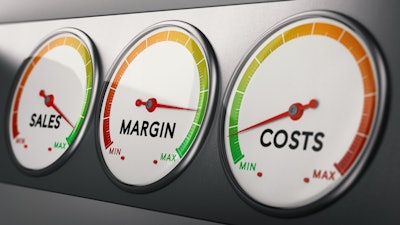
It’s been a challenging three years for businesses with the pandemic, supply chain disruption and record levels of inflation creating market volatility and upsetting previous plans.
Sandwiched between manufacturers and retailers, distributors have been in a uniquely complex position, experiencing pressure from all angles which continues to threaten margins. With the global economy still shaky, there are likely to be more challenges on the horizon for distributors.
As the cost of raw materials remains high and inflationary pressures drive production costs up, distributors are faced with stubbornly high prices from manufacturers. Meanwhile, sell-side, retailers are searching for the lowest prices on the market as they feel the strain of cost-conscious customers. Distributors are tasked with balancing these two opposing pressures of keeping costs down to attract and retain customers, while offsetting price rises from manufacturers, and also taking into account the climbing costs of warehousing and transportation.
To cope with the level of fluctuation and volatility on both the buy-side and the sell-side, distributors need the capability to implement pricing strategies that are resilient and based on real data and current market trends.
Pricing Is Distributors’ Most Powerful Lever of Profit
Pricing is the most powerful weapon in a distributor’s arsenal, with price having a disproportionate impact on a distributor’s market value compared to other industries. For distributors, just a 1% price increase can result in a 20% increase in enterprise value, according to McKinsey. However, businesses have historically neglected pricing as a profit lever due to concerns that price rises would alienate customers.
But a recent survey found that this isn’t the case, with price ranking as only the sixth most important factor that customers look for in a distributor. Customer loyalty is much more likely to be influenced by the breadth of their offering, level of availability and customer service. It stands to reason that if a distributor can maintain a good level of stock availability while meeting other needs such as same or next day delivery, then a calculated, strategic price adjustment is unlikely to scare customers away – while being very likely to have a marked positive impact on profit margins.
To ensure price doesn’t become a determining factor, distributors should maintain and protect prices on key value items where customers are most price-sensitive, while raising prices on other items where the opportunity to increase margins is biggest.
Digital Transformation
When it comes to pricing, the wholesale-distribution industry has largely avoided the need for digital transformation, but this is no longer an option. Market volatility means manual price management has the potential to be catastrophic for a business. Traditionally, managing buy-side and sell-side pricing, including individual deals and rebates, has been a time-consuming and resource-intensive process, leaving little room for real-time profitability analysis. With distributors juggling complex pricing spreadsheets, rebate claims and accruals, these manual processes are also prone to human error.
To address these challenges, businesses can leverage intelligent, automated pricing solutions. By automating pricing processes and linking cost data to pricing decisions, distributors and wholesalers can gain instant visibility into their margins across various customer segments, sales channels and product lines. This approach enables businesses to make data-driven pricing adjustments that improve revenue and profitability while reducing the risk of under-pricing products.
Automated pricing also streamlines pricing administration tasks, allowing sales teams to spend less time on manual processes and more time engaging with customers. This increased efficiency enhances the sales process and enables businesses to adapt quickly to changing market conditions.
Rescuing Rebates
Rebate management for distributors can often become difficult to navigate when done manually, with errors and discrepancies creeping in and contributing to an average loss of $2.65 million in unclaimed rebates each year.
Intelligent pricing offers a solution to mismanaged rebates, with automated data collection and processing ensuring accuracy and consistency in rebate calculations. This enhances trust and transparency between distributors and suppliers, while reducing administrative burden and creating a smoother operation.
Real-time access to data also enables distributors to align their rebate structures with buying patterns and seasonal trends, generating rebate programs tailored to customer needs, which improve customer satisfaction and incentivize loyalty. This frees up time and resources for more strategic tasks, such as building stronger supplier relationships and devising innovative marketing strategies to drive growth.
Building Resilience Through Intelligent Pricing
By leveraging intelligent, automated pricing, distributors are empowered to strike the essential balance between providing competitive prices and maintaining healthy profit margins to secure long-term success. As fluctuating demand, high production costs and inflation continue to impact the sector, having a pricing strategy informed by real-time data and market trends will be key to reducing revenue leakage and maximizing margins.
Cath Brands is the chief marketing officer at Flintfox.






















